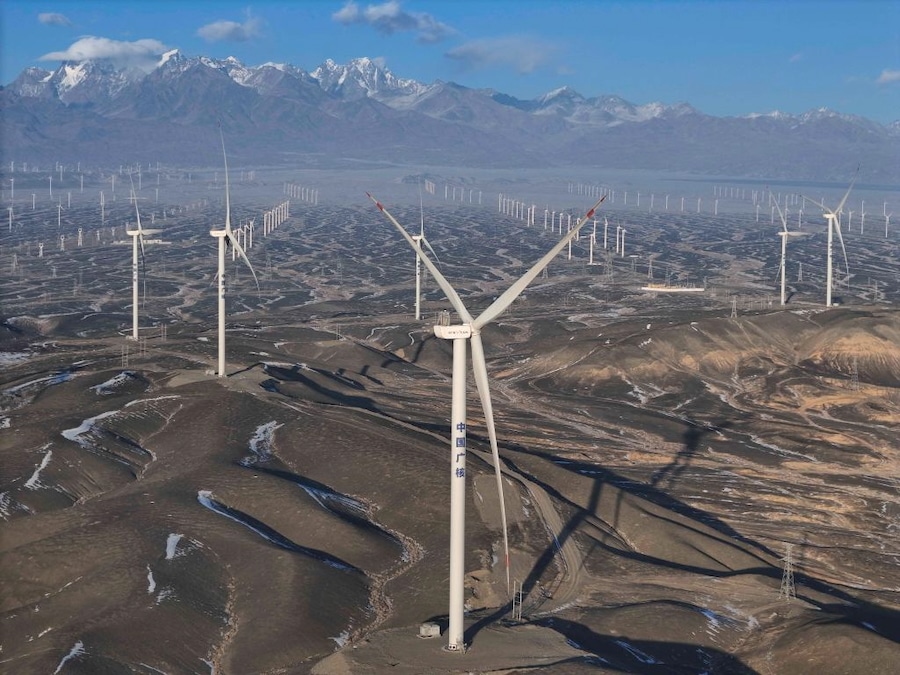This post was originally published on Eco Watch
China broke its own records for the installation of new solar and wind power last year, with installed capacity increasing by 18 and 45 percent, respectively, according to new data released by the country’s National Energy Administration (NEA) on Tuesday.
Solar and wind power surpassed 1.4 billion kilowatts (KW) in 2024, reported China Daily, adding to the country’s reputation as a world leader in renewable energy development.
Belinda Schäpe, a Centre for Research on Energy and Clean Air (CREA) China policy analyst, said that while the country continued to expand its coal capacity, “this massive scale of renewable power additions has positive implications for emissions in 2025,” Recharge News reported.
“Renewables may reach the turning point where they can meet all of the electricity demand growth, which would make it more likely for China to achieve its emissions peak and structural decline from there,” Schäpe said.
Solar’s installed capacity soared to 890 million KW last year — a 45.2 percent increase from 2023 — while wind-generated power capacity reached 520 million KW, an 18 percent climb, NEA said.
President Xi Jinping in 2020 set a target of a minimum of 1,200 gigawatts (GW) of wind and solar capacity by the end of the decade, which was met almost six years early, NEA data from August revealed, as reported by Electrek.
China has built nearly twice the wind and solar capacity as all other countries in the world combined. It is also the biggest producer of electricity on the planet, and power consumption jumped significantly to 9,852 terawatt hours — up 6.8 percent — in 2024.
While China still uses coal, coal power permits fell by 83 percent during the first half of fiscal year 2024, compared with the same period a year earlier, CREA said. There were also no new approvals of coal-based steelmaking projects during that time.
“The country is committed to further promoting the growth of renewable energy and actively advancing the transformation of its energy mix from a reliance on coal to a more balanced structure,” said Lu Ruquan, head of China National Petroleum Corp Economics and Technology Research Institute, as China Daily reported.
China’s energy transition last year benefited from substantial investments, such as $83.7 billion put toward power grid infrastructure — a 15.3 percent increase from the previous year.
“These investments facilitated the construction of large-scale renewable energy projects, the modernization of grid systems to handle the variability of renewable sources, and the deployment of advanced storage technologies. The expanded grid infrastructure played a critical role in connecting remote renewable energy hubs to urban demand centers,” China Daily said.
Lin Boquiant, head of Xiamen University’s China Institute for Studies in Energy Policy, said the government’s long-term policies, such as subsidies, tax incentives and renewable energy quotas, have incentivized investment in clean energy. Meanwhile, the country’s push to reach peak carbon emissions by 2030 and be carbon-neutral by 2060 has added urgency.
Lin said that innovations in wind turbine design and the efficiency of solar panels have brought down costs while improving the reliability of clean energy systems.
“It will be critical for the government to capitalise on the momentum in the renewables sector. As expected, renewables additions were much higher than the government had targeted. Instead of lowballing these targets, the government should put forward strong targets for the renewables expansion for the next decade, alongside a detailed plan for phasing down coal power,” Schäpe said, as reported by Recharge News.
The post China Sets Wind and Solar Installation Records for Second Year in a Row appeared first on EcoWatch.





0 Comments